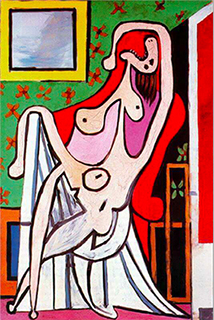The beach scene in the title drawing for Une Anatomie inevitably associates the 27 figures that follow with the theme of the bathers, a theme Picasso consistently returned to throughout his life. And yet, the figures that follow the title page make no reference to bathing. On the other hand, the theme of bathing and more specifically swimming does resonate with Marie-Thérèse and her passion for swimming and athleticism generally. Substituting his wife with his muse on the title page gives Marie-Thérèse a concrete presence, albeit one that inevitably adds a certain puzzling, if not sinister dimension, which now requires further unpacking. The following quote by Françoise Gilot provides us with a clue as to how we might do that, “Often when he (Picasso) was at Boisgeloup with Olga and family friends, he pictured Marie-Thérèse bathing in the Seine near Paris. The next day he might return to Paris to see her, only to learn that she had bicycled out to Gisors to be near where he was. She haunted his life, just out of reach poetically, but available in the practical sense whenever his dreams were troubled by her absence.” (Gilot 1964: 235). This quote both answers and at the same time reinforces the earlier question concerning the disparity between the bathing theme on the title page and its absence in the rest of the drawings. The 27 figures that follow the family on a beach drawing make no direct reference to bathing and this numerical imbalance may account for the fact that he predicated this series of drawings with the title Une Anatomie and not Bathers. Was it his intention to draw our attention to their surreal skeletal anatomy—as opposed to any action, such as bathing or swimming that they may have been engaged in—whilst at the same time using the beach hut to infect the theme of Une Anatomie with that of bathing?
Marie-Thérèse the Drowning Goddess
When we objectively examine the anatomy of these “conceptual sculptures” words such as assemblage, skeletal and totemic spring to mind, which is the inverse of the sexually nubile and athletic forms normally associated with Marie-Thérèse, who had a passion for swimming, and athleticism in general. Therefore, one wonders if the title Une Anatomie (An Anatomy, singular) was intended to draw our attention to a poignant need to focus on her reconfigured anatomy as portrayed in this series of drawings and, if so, why? Another distinctive feature is that these skeletal forms have retained their sexual identity and are not reduced to the sexless amoebic forms that Picasso ruthlessly subjected Olga to when she incurred his anger, as in, for example, Nude in a Red Chair, 1929 (Fig.17). If the anatomy figures are portraits of his young lover, why did Picasso deny her the voluptuous qualities that made her so desirable? The answer to this question may lie in an event that occurred shortly after the 25 October 1932, Picasso’s fiftieth birthday.
Accounts of the event vary but the outcome is consistent. Marie-Thérèse contracted spirochetosis, a highly infectious and sometimes fatal disease as a result of either swimming, or a kayaking accident on the river Marne near Paris. In his essay “Picasso's Blonde Muse: the reign of Marie-Thérèse Walter”, Robert Roseblum wrote, “Maya Widmaier-Picasso informs me that in 1932, her mother, always a passionate swimmer, contracted a spirochetal disease by swimming in the infected waters of the Marne”. (Rosenblum 1996: 383) Richardson’s account is more dramatic and involves the oars of Marie-Thérèse's kayak becoming entangled in weeds, which then caused the boat to capsize and she nearly drowned. Given the time of year that the incident occurred the Marne River would have been extremely cold and therefore kayaking and not swimming seems to be the more likely scenario. Either way it’s thought that because of a cut on her foot she contracted the spirochetal disease because the river was polluted with rat excrement and sewage. The resulting illness was so serious she required hospitalisation and its visible effects were substantial weight and hair loss. Her sister, who was a doctor, looked after her during her illness and is quoted as saying, “Her illness required a long convalescence and it was thought that she was going to die. She lost all of her hair and had become skeletal.” (Fabre 2011: 123). Diana Widmaier Picasso also made a similar observation regarding the outcome of the incident when she described Marie-Thérèse’s normally athletic and curvaceous body as becoming “bone-thin” (Widmaier Picasso 2018).
